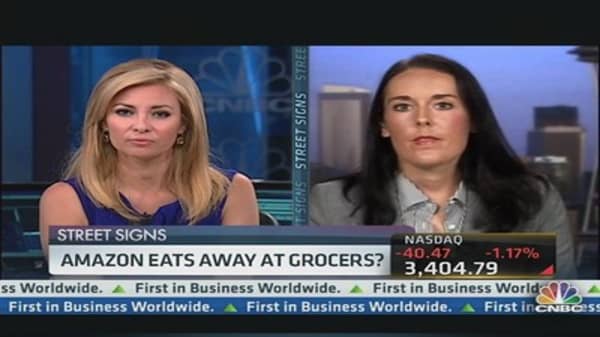While Amazon's revenue is far higher than Wal-Mart's online revenue, Wal-Mart is a fierce grocery competitor that Amazon will have to face on the ground.
Jan Rogers Kniffen, CEO of consulting group J Rogers Kniffen WWE and a former department store executive, said the world's largest retailer wins on price every time. While he acknowledged there are small fluctuations in the numbers from week to week, Kniffen said the most recent data show that compared to Wal-Mart, Target's prices are 3.2 percent higher, SuperValu's prices are 15.7 percent higher, Kroger's are 16.7 percent higher, and Safeway's are 21.9 percent higher. Even when comparing Wal-Mart's grocery prices to dollar stores—which have taken some market share from Wal-Mart in recent years—the retail giant still offers lower prices.
"One wonders why anyone needs to buy groceries anywhere else unless you want to go to a Whole Foods-type retailer, which is more of a niche, or to a Stew Leonard's, which is an experience," Kniffen said.
Wal-Mart already sells more groceries than any other U.S. supermarket. In 2012, 55 percent of Wal-Mart's U.S. sales were grocery items, amounting to nearly $151 billion. That's just $7 billion less than the annual revenue of Kroger, Safeway, and Supervalu combined.
(Read More: Wal-Mart Pushes to Sell More Produce)
The discounter has been aggressive in the fight for grocery business. Wal-Mart has been airing grocery price commercials comparing its prices to regional grocers such as Giant Eagle in Pittsburgh and Publix in Florida, which feature customers taking receipts from recent grocery shopping trips at competitors and comparing prices against Wal-Mart's prices. According to the commercials, the savings are usually around 20 percent.
Months ago, Wal-Mart announced a program working with First Lady Michelle Obama to offer healthier food options in its private-label items, and just this week the retailer detailed a new program guaranteeing the freshness of its produce, offering consumers' their money back if the freshness falls short.
(Read More: As Americans Rush to Fresh Food, Supermarket Chains Follow)
While Wal-Mart does not have a true online grocery store here in the U.S., its Asda grocery business in the U.K. does. In a recent research note to clients, Citi analyst Deborah Weinswig wrote: "We believe that Asda's expertise with these technologies could be the secret sauce that gives Wal-Mart the advantage in the race to develop online grocery in the U.S."
What About Profit?
That said, grocery, online or off-line, remains a low-margin business. "Grocery is among the thinnest margins out there in retail. The average grocer probably gets a 2-, 2.5-, to 3-percent type operating margin. That's a very slim margin, and that's before interest and taxes," Telsey Advisory's Feldman said.
That doesn't mean it's a turn-off for the online behemoth, Feldman said. "Amazon's history has been all about capturing market share and going as low as they can possibly go on price, sometimes even taking losses from what we can tell, if that's the case, I don't see why grocery would be any different, he said."
Susquehanna's Summers suggested it's possible Amazon could augment a very strategic pricing model for its grocery items as it aims to grab new market share in grocery. "Amazon isn't afraid to sell products at incredibly low margins. Maybe it will price the items that drive value perception aggressively, but then price most other grocery items at or slightly higher than competition," he said.
The real profit would likely come from shoppers adding other non-food goods to the cart. Many speculate Amazon and Wal-Mart's real goal with grocery is enticing consumers to add a DVD or two on the way to check-out.
A true student of retail, consultant Kniffen has studied how the grocery business has changed for decades, and he expects Wal-Mart has been the greatest disruptor to the traditional grocery model so far.
"Can Amazon be a threat? Yes, but boy it is a tough place to make a buck."





